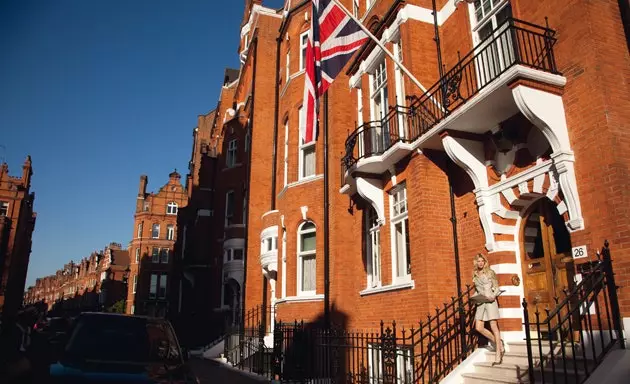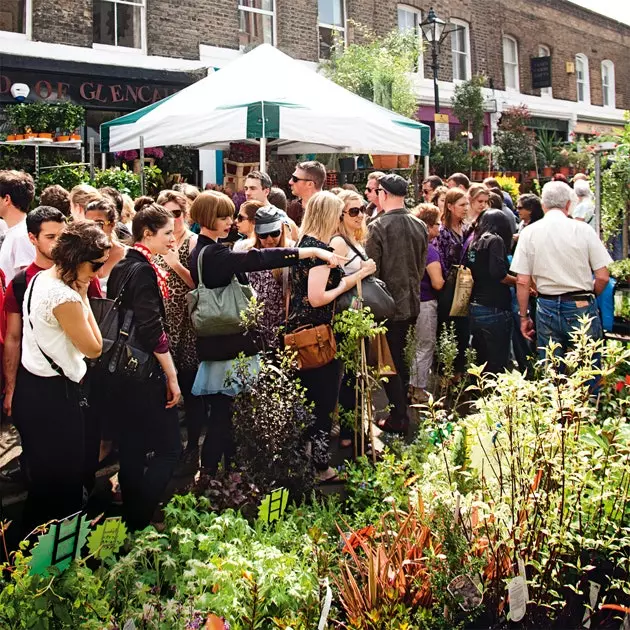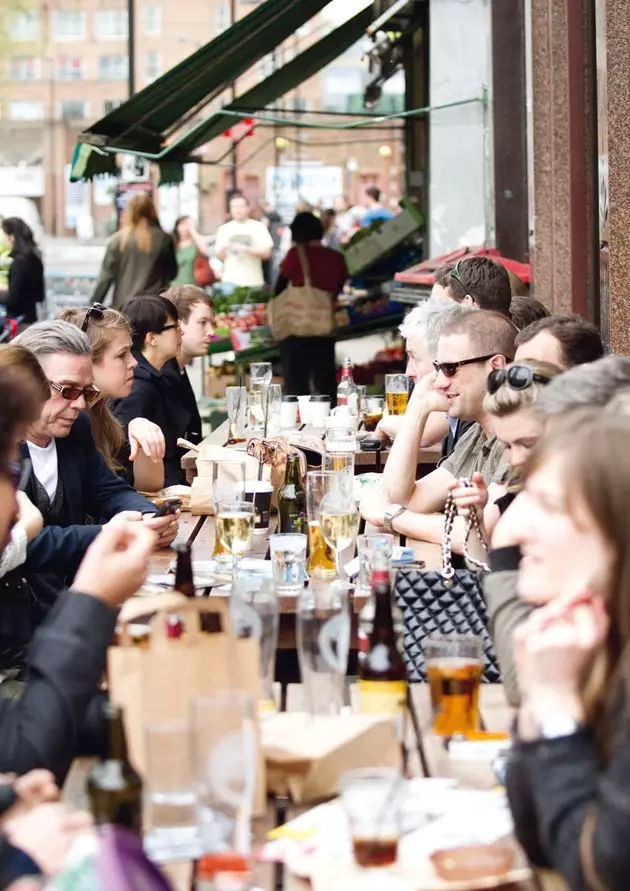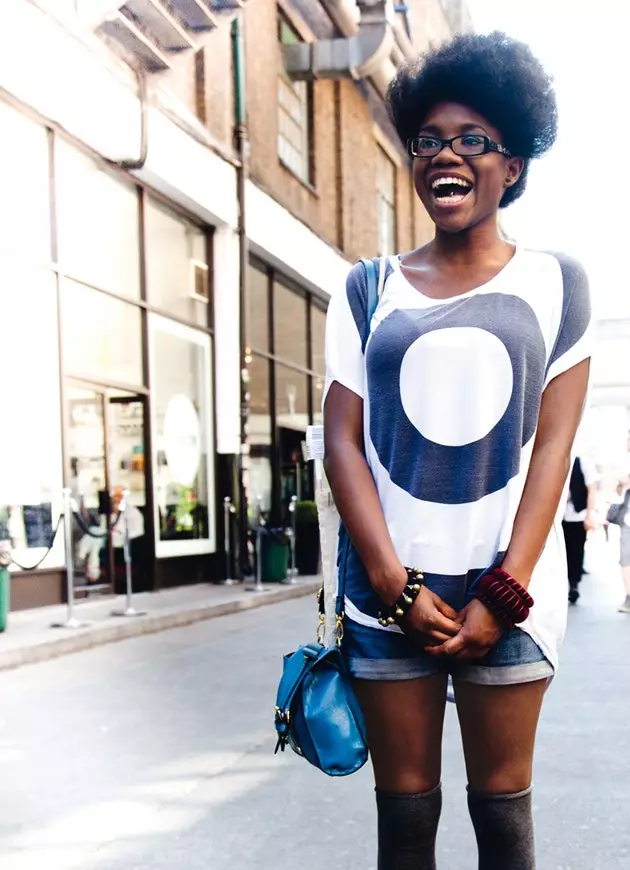
Draycott Hotel Staircase
Conservative and eccentric like a good British, London is a rigid city on the outside and irreverent on the inside. "Do what you want, but for God's sake don't let it show," he seems to warn. And the best example of this is the Chelsea neighbourhood, "the reasonable option for people who could afford not to be" in the words of Hugo Young, biographer of Margaret Thatcher . The Iron Lady lives in Chelsea, just like the Rolling Stones and Bob Marley did when success made it possible. Gwyneth Paltrow, Kylie Minogue, Eric Clapton, Bob Geldof, Hugh Grant, William Boyd, Julie Christie... have been or are neighborhood residents. The list is endless. Millionaires may live elsewhere, but the very very rich, if they like, move here. And I also, without knowing it, always wanted to live here.
As a child I fantasized about living in London, in one of those typical houses with a staircase at the entrance and stained glass windows where I could sit and read and watch the rain. A large poster of Tower Bridge, the Tower Bridge, presided over my room, watching over my dreams. Since I took down that poster –and post-adolescence made me yearn for New York– I have traveled to London eight times. Quite a few or very few, depending on how you look at it. Insufficient in any case since, although I fulfilled all the visits of the good tourist and I thought I had found my longed-for home in Holland Park, Kensington Gardens, Notting Hill and even in Clerkenwell, so fashionable in the 90s, never before have I been carried away by the harmonious arteries that descend from Knightsbridge and its luxury department stores to the river. Big mistake.
Located between the green mantle of Hyde Park and the River Thames, which at this point of its course overlooks the glorious Battersea Park and the factory chimneys that once illustrated the famous cover of Pink Floyd, Chelsea shares a municipality and quality of Royal Borough with the neighborhood of South Kensington. But unlike its aristocratic neighbor and brother, home to the lavish museums left behind by Prince Albert, Queen Victoria's handsome lovelorn husband Chelsea, who originally it was a fishing village, he always had a more bohemian bent (and a magnet for writers and artists).
Bohemian and even subversive/defiant, much to the taste of Oscar Wilde, who was arrested for homosexuality at the Cadogan Hotel, on Sloane Street, in 1895. In the mid-sixties of the last century, Chelsea was experiencing a catharsis of creativity, disinhibition and self-assurance. The post-war children, educated in the best schools and with good money in their pockets, wanted to have a good time and do it their way.
The mod became fashionable, and bangs for boys and miniskirts for girls. Punk arrived, or at least it became evident from the store of designer Vivianne Westwood, then a partner of Malcolm McLaren, representative of the Sex Pistols. To a certain extent, if London has swing, cheekiness and rebelliousness it is thanks to fashion made in Chelsea. Those girls who cut their hair to the garçon and shortened their skirts according to the canons of Mary Quant and her muse Twiggy today walk with their dogs (you have to keep up the type) or go to the spa dressed in Chanel.
The still young, all handsome and tanned, seem to enjoy idling in cafes. No rush, it seems, no worries. The crowds in front of the embassies are the only shocking element. "Excuse me, the entrance to the subway?" "I'm sorry, I do not know". Nobody knows. This is how the days go by in Chelsea. During the weekend, yes, the neighborhood is empty. It's what happens when everyone has a mansion in the countryside. So, if you're here on a Sunday, head to the Brompton Oratory after mass, or to the Chelsea Physic Gardens, a pharmacy garden where you can learn about the medicinal uses of plants.
The parade of ferraris, porsches and land rovers is constant in the quiet alleys of the triangle formed by Brompton Road, Sloane Street and Draycott Avenue. It is the heart of Chelsea. Typical red brick Protestant architecture, with its private gardens where to see spring sprout, was imported by the builder Ernst George after a trip to the continent. The noise of the luxury motors, however, is completely silenced by the chirping of the birds and the song of the children playing at recess. How many schools are there in Chelsea? I don't know, but the truth is that children's voices are heard everywhere. I feel close to Mary Poppins and her friend the chimney sweep , but it takes time to find a connection between this feeling (subjective, like a good feeling) and the fact that Peter Pan was, precisely, from here.

Columbia Road Flower Market
Although Chelsea is essentially a residential neighbourhood, that doesn't mean it doesn't have room for culture, shopping and entertainment. Quite the contrary. Around Sloane Square, home to the Peter Jones department store (go up to the top-floor café, the views are from a window display), all the international luxury brands you can name gather: Tiffany's, Chanel, Armani, Christian Laboutin , Hugo Boss, Heidi Kleim… and one of its main streets, King's Cross (intimidating on the map but close and accessible on foot) it is one of the great commercial arteries of the city . For clothes shopping it might be wiser to head to Oxford Street, but if you're looking to decorate your home don't hesitate: head straight to the Mint and Few & Far , owned by Conran's sister Priscilla, in a bright, changing space. fully every six months. Everything stays in the family.
The vintage offer is also excellent (much better than in the East End!; logical, considering the wardrobe that the residents of the neighborhood have been getting rid of). You will find authentic jewels and bargains in Octavia Foundation and curious Louis Vuitton suitcases and bags, among other jewels with history at Bentleys. When you get tired, sit down to have a drink, surrounded by flowers, in the Chelsea Farmers Market, where an excellent ice cream parlor, Dri Dri, has just opened, or at the Saatchi Gallery's Cafe Mess in Duke of York Square. Although surely there, in his store, you also buy something.
On the other hand, the gastronomic offer may not be as extensive, excellent and risky as in other areas of the city, but it has lots of nice little restaurants —see Walton Street's succession of organic trattories like Jak's, which is also home to the sophisticated but fun night bar Eclipse (nº 111-113) —, tempting cafes with terraces where you can sit down to have a copious salad and enjoy the human walkway and a good handful of prestigious restaurants, such as Tom's Kitchen , perfect for breakfast and one of the usual places in Catalina and Prince William; Blue Bird Café , with a select food store that will whet your appetite even more; Ransoi, the intimate universe of Vineet, the only Indian chef awarded twice with a Michelin star ; San Lorenzo, which they say feeds the largest concentration of the rich and famous per square tablecloth; Bibendum and his oysterbar, housed in the former Michelin factory, refurbished with impeccable taste by Terence Conran (there's a tempting book and home store on the lower floors); and a branch of the scrumptious Gaucho, arguably the best steak in town, with permission from Daniel Bouluddel's new French brasserie at the Mandarin Oriental Hyde Park.
Near here, next to the big park and the most famous stores in the world, Harrod's, it is worth entering, during the day to eat or at night to have a drink, The Roof Gardens, part of the empire of Sir Richard Branson. And then, of course, there are the patisseries: Valerié, Pôlaine, Peggy Porschen, where Madonna herself is unable to resist her cupcakes.
So unlike Elvis Costello, who sang I don't want to go to Chelsea back in 1978, I hope to return. If not to live, at least to visit a friend who lets me read all the rainy afternoon next to his window. Although, if not, I always know that I will have the Draycott Hotel, a true English home (yes, with a private garden from which to listen to the children play and a window from which to read on rainy afternoons) in the heart of the neighborhood in which that we would all like to inhabit.

Cat and Mutton Pub Terrace
Heading to the vibrant East End
Across town, a universe away, a navy blue Bentley pulls up to Bethnal Green Town Hall, in the municipality of Tower Hamlets. The civic white building gleams among everyday grocery stores, mechanical workshops and places without a clear purpose. An elegant couple waits in the back seat while the uniformed chauffeur approaches to inquire: "The restaurant Traveler, please?". "Yes, sir, go ahead this way, through the hotel, or around the corner again, there is the main entrance to the restaurant."
This scene is common outside the Town Hall, the new luxury hotel that Singapore tycoon Peng Loh has opened in this still unexploited area of the city. Crazy, some think, a visionary, others think (like me). Be that as it may, the hotel boasts of its support of art (pay attention to designer chairs) and of having the largest suite in all of London, though the newly reopened's oversized royal suite may The Renaissance from St. Pancras station has won the game.
More and more West Londoners are daring to venture into the eastern flank of the East End, where the normal map of London is lost, attracted by the restaurants and creative energy that trend magazines and friends talk about. , eccentric yuppies, who have already moved here, but this leaves neither confusion nor surprise for those who have never come here before. At the end of the 20th century, London's East End was still synonymous with immigration, sleaze, stale pottage and base instincts. (and other ghosts of Victorian puritanism) and the only tourists to be seen east of Liverpool Street Station and the medieval city limits were those on the Jack the Ripper tours—if you're interested in the Cloak & Dagger Club organizes meetings at The Dirty Darts pub on Commercial St and at The Ten Bells, a little further up, where two of the victims drank the night of their deaths.
This rebellious and anti-establishment area was beginning to be the YBA (Young British Artist) games room, but although the Whitechapel Art Gallery (don't miss the openings every first Thursday of the month) had a century of exhibitions —curious fact : in the London Hospital, behind the tube station, the body of John Merrick, 'the elephant man', is kept—, it was not until the opening of the very modern WhiteCube Gallery, in 2000, when the eyes of culture (and of fashion) began to look to the East.
First there was Bricklane, the Bangladeshi curry street, and Spitafields, with its famous market, then Shoreditch, Hoxton, Bethnal Green, Hackney... The process of gentrification (urban transformation, gentrification) classic: the artists arrive first, attracted by the large empty spaces, the cheap rents and the bad (or good, depending on how you look at it) life, then the insiders, the creative professionals, the boutiques, the restaurants, luxury hotels raise prices and you have to move, find new spaces for creativity.
Today the wave continues unstoppable towards the northeast, towards Stratford, accelerated by the construction of the Olympic Village and the new metro lines. And while these lines are being written, the advance guard, not yet too visible to the mainstream, is already in Dalston and Clapham Junction, although there are some who have already decided to jump to the south bank of the Thames, mounted on the wagons of the modern Ginger Line.
But you don't need piercings and custom clothing to fall in love with the East End. Sir Terence Conran, father and lord of the Habitat empire and undisputed guru of trends at 80 years old, confesses in his restaurant guide 'Eat London' that the East End is his “favorite area of the city. Creative, vibrant, innovative, it is home to the most original talent and the most interesting corner of London. The future of him exudes life”.
Chef Numo Mendes, responsible for the gastronomic phenomenon that was the Bacchus pub in Hoxton, and now at the helm of Viajante, couldn't agree more. “The East End is a summary of the world. It is the place that inspires me the most”. Mendes, who worked with Jean Georges in New York and with Adriá at El Bulli, continues, “also, chefs are more competitive there, in the West End, in Soho. Logical. But here we support each other, and gastronomy is still a reflection of the society in which we live ”. He smiles as he points out some of his favorite neighboring restaurants on the map: Bistrotheque (with cabaret show), very trendy and rightly so; Brawn, honest, traditional and seasonal, perfect for going on a Sunday; St. John, now with a branch opposite Spitafields Market (the original is in Smithfield).
“I also recommend Paul Tvaroh's cocktails at Lounge Bohemia (by appointment only and suits are prohibited), they're the best,” he continues cheerfully, “and Climpson & Son's coffee, which they also serve at Wilton Way Cafe , in Hackney. Did you know that the best baristas in London are Australians and New Zealanders? What Nuno also knows is that now what is popular are pop-up restaurants, clandestine restaurants, without a license, in private homes, abandoned places or even, as the girls from Ginger Line organize, in secret places along the line of East London tube, where the experience is completed with sales of local designers, art exhibitions and maybe even shows. More underground, impossible. The place, time and password are disclosed shortly before, by SMS, mail or Facebook.
The 'recommended donation' also varies. Last summer Tom, Pablo and David from the bistrotheque they set up a pirate restaurant (albeit with permission) on the roof of the future shopping center of the Olympic Village. Mendes himself has been with The Loft Project in the living room of his house, to which he invites a chef every month to prepare a menu of seven or eight dishes for 16 people (€135, with wines and cocktails). “It is about giving opportunity to cooks with ideas and without possibilities.
We function as a gallery of chefs : we offer them the stoves, an assistant and a cook so that they can be exhibited”. Sometimes the guest artist turns out to be someone like René Redzepi, from Noma. Other similar projects, with less ambition or contacts, are limited to home cooking, generally organic, for the fun of it. The Secret Ingredient Japanese Vegetarian Cuisine. Greg and Maya from The Brunch Club, they prepare brunch with fruit from their garden in their Hackne garden, and ex-chef Tony Hornecker recreates a cabaret 'extravaganza' in a warehouse that looks like something out of a David Lynch movie. "Grace is visiting a family home with all the consequences," says Ms Marmitelover, a former photographer for the New Musical Express who teaches cooking courses, "and in mine, my teenage daughter is the waitress."

The cheerful and carefree atmosphere reigns in the East End
Something similar happens in the night scene. Fed up with the abusive prices and the long queues to enter the clubs, people turn their terraces, patios and lounges into improvised gambling dens. They are parties with 'recommended donations'. The question is: how does one know where to go? “Facebook, twitter, word of mouth,” replies Charlotte Hall of LN-CC, one of the latest concept stores to open in Dalston. Hidden in a dreamlike basement with no name on the door —near the much-loved Geffrye Museum (136 Kingsland Road) , dedicated to the evolution of home interiors, highly recommended for children—, you need a prior appointment to go down and browse among its careful selection of Japanese, Australian, British firms...
“We are not a typical store. We don't want people walking in and out. The idea is to tell them what we do, what we have, direct treatment. It doesn't matter if they buy or not, but we want to surprise them, bring something different”. LN-CC is also an unconventional library. And a space for DJ sessions. And there will be more. It seems impossible to keep up in the East End. "Everything changes so fast, that only those of us who dedicate ourselves to this professionally can be up to date," Kevin Caruth, founder of the company of specialized private guides (shopping, urban art, gastronomy...) Urban Gentry assures me.
But today is Saturday and everyone knows that you have to go to the Broadway Market organic market (from 9 a.m. to 3 p.m.; and there is much more than food) to have brunch, to do the shopping for the week, to browse through the alternative markets that are available on any available plot of land or, simply, to relax on the lively lawns of London Fields Park (yes, like the novel by Martin Amis) or to stroll (better by bicycle) along the Regent's Canal in search of the graffiti that you will later see in the galleries of Shoreditch.
Following the canal you can get closer to Wilton Way, a quiet district yet to be discovered, where you can enjoy the homemade scones of violet , visit the extraordinary Posted gallery, housed in a former post office, and sit down with a pint of beer in the garden of Spurstowe Arms , where I think you won't regret it if you stay late at night...
The many small shops and cafes around Broadway Market thrive on market activity. Many are only open from Thursday or Friday to Sunday, the rest of the days they do not do business. The same thing happens on Sundays around columbia road flower market (from 8 a.m. to 3 p.m.; again, much more than just flowers) and the Sunday UP Market on Brick Lane, a more typical market. Thrift stores abound around eclectic Brick Lane , but you can also find delicious boutiques like Dragana Perisic (Cheshire Street), a Serbian designer who, in addition to feminine dresses and coats, makes superb leather bags in elegant colours. Following Brick Lane south towards the Great Mosque leads to the Spitafields Covered Market and the Old Truman Brewery , an old brewery now home to over 200 designers, gallery owners, bars, restaurants, nightclubs and more fleamarkets. .
And continuing north, we end up in Redchurch St., a street, a block, really, that would deserve a report on its own. So short and sweet, Redchurch has it all and yet there's something new every day. Skaters, graffiti, a homeless man, a couple of movie production companies, two French apothecaries, three art galleries—my favorite, Idea Generation, is actually on 11 Chance St.——a lively pub, a shop for the elegant gentleman of the East End, Hostem, a Baroque Lover's Lounge Bar , decoration stores as curious as Caravan and Labor&Wait, several cafes, as many fashion boutiques, a small cinema, The Aubin Cinema, the kind with armchairs for two, blanket and cushion, and a designer boutique hotel, The Boundary (HD : from €325), the person responsible for so much animation.
The Boundary has only 17 rooms with the unmistakable stamp of Terence Conran (him again) and three restaurants, the informal Albion, also a delicatessen, at street level, the sophisticated Château Boundary in the basement and, here comes the best, The Roof Top , the sought-after rooftop brasserie bar. Just around the corner lies East Pizza, the place of the moment, and Les Trois Garçons , a fantastic gastro-pub decorated like a trip lysergic. Two blocks north is leafy Calvert Avenue, taking its cue from Redchurch St. and a new space pops up every day, adding to Hassan Hajjaj's ethnic pop art store The Studio and the organic delights of Leila's Shop.
And after reading all this, Do you really still want to fool around at Oxford Circus and Camden Town? , because I, nowadays, see no reason to go to the rest of London.
This report was published in issue 41 of Traveler magazine
